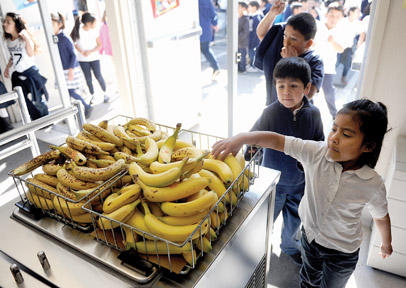Federal guidelines will be implemented starting in 2012-13, with final changes in 2022-23
Federal guidelines will be implemented starting in 2012-13, with final changes in 2022-23
School lunches will look a whole lot more colorful when classes start in the fall. Several broad changes to the National School Lunch Program include offering fruit daily and offering a variety of vegetables that cover different types each week.
Janet Felice, the manager of food and warehouse services for the Hollister School District, said the new approach to offering fruits and vegetables is the idea of serving “a rainbow” each week.
“You can’t offer celery every day,” Felice said. “It’s regulated to include dark greens, leafy greens, red or orange vegetables (for example.)”
The Healthy, Hunger-Free Kids Act of 2010 was finalized in January, with the first changes coming to school districts for the 2012-13 school year and the last changes to be implemented a decade later.
According to the United States Department of Agriculture, the 2010 legislation provides the first major reforms to the school lunch and breakfast programs in more than 30 years.
“The USDA has to reauthorize the legislation every five years but this time they did an overhaul,” Felice said.
Though the act was authorized in 2010, the legislature allowed a public comment period for vendors, school district personnel and others to comment before the final guidelines were released in January.
The changes for the coming school year include increasing the number of whole grain-rich foods offered to at least 50 percent of the offerings and increasing the range of options; offering only fat-free flavored or unflavored milk and only low-fat (1 percent) unflavored milk for lunch and breakfast; lowering the calorie maximum for lunches; lowering the number of trans fats per portion to zero grams for lunches; and some administrative changes such as changing from a five-year to a three-year administrative review cycle. Many of the changes to breakfast items will go into effect in the 2013-14 school year.
The one change that has met some resistance is new sodium targets for the meals. The final target will not be implemented until the 2022-23 school year to give more time for review and to allow vendors time to change their offerings to meet the guidelines. For instance, the amount of sodium allowed per meal for breakfast is 573 milligrams for the next school year. The amount will be reduced to 540 in 2014-15, then 485 in 2017-18 to a final target of 430 in 2022-23.
“Some issues the vendors are having is that naturally-occurring sodium is sometimes higher than what is allowed,” she said.
As an example, one cup of cottage cheese with fruit would have 777 milligrams of sodium while a four-inch bagel would have 460 milligrams of sodium; both are over the final sodium target. Health experts recommend that children ages 4-8 have a maximum of 1,200 milligrams of sodium a day.
Felice said the Hollister School District has already changed to offering only fat-free or 1-percent milk and has increased the number of whole-grain items that are served with the meals.
“The vendors already started that,” she said, adding that bread and cereal items will include whole grains.
She said the vendors have already worked on lowering sugar and fat content as well to meet the new guidelines, which in turn will help schools meet the lower calorie requirements. Despite the changes, some of the portions will be bigger for kids.
The calorie guidelines had changed and that they are now based on more age-appropriate ranges, Felice said. Previously, kids in fourth through 12th grade were offered the same number of calories. Now the age ranges will be K-5, 6-8, and 9-12.
She said the school offers a certain number of items and children are allowed to pick which items they want, though Felice said she believed the new guidelines will require the students to take a certain quantity of fruits and vegetables each day. The kids are not allowed to take food items with them after the lunch period ends so there may be concerns with students having enough time to eat the full portions.
“They have a limited time to eat so that is always an issue,” Felice said, noting that 66 percent of children enrolled in the Hollister School District this year qualify for the free- or reduced-lunch program.
Felice said leftover food is donated to the Community Food Bank, though most schools have the amount they need to order dialed in pretty well.
The healthier food options will cost local school districts more money, though Felice said she wouldn’t have exact figures until she goes out to bid later this year. She said the estimate is that the cost will be 30 cents more per meal and the federal government is increasing reimbursements by 6 cents per meal.
Recommended sodium intake for children
The Mayo Clinic’s guidelines for sodium intake for children ages 4 to 8 is a maximum of 1,200 mg. per day and for ages 9 to 13 a maximum of 1,500 mg. of sodium per day.
Sodium content of common foods:
1 c. canned tomatoes – 1284 mg.
1 c. chicken noodle soup – 823 mg.
1 c. macaroni and cheese – 761 mg.
2 slices of salami – 402 mg.
3/4 c. Cap’N Crunch cereal – 186 mg.
1 c. apple slices – 0 mg.
From the USDA National Nutrient Database for Standard Reference










